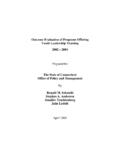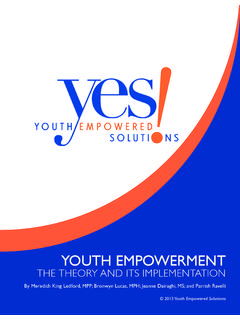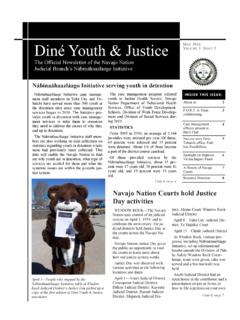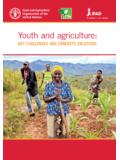Transcription of Working with Vulnerable Youth - Office for Youth
1 Working with Vulnerable Youth Key Concepts and Principles 2 | Working with Vulnerable Youth Key Concepts and Principles key concepts and principles 1. 2. Vulnerable Definition ..3 Vulnerable Youth Framework .. 3 Risk and Protective Factors .. 4 Groups .. 6 What works? Key approaches with Vulnerable young people .. 6 Young People and their Young People and their Young People, Learning and Service responses .. 7 3. Principles for Service Organisations No wrong door .. 8 Needs-informed services that respect human rights .. 8 Proactive .. 8 Flexible service models .. 9 Evidence based services .. 9 Measuring client 9 Continuous improvement and reflective practice.
2 9 Planned 9 Working with particular groups of young people .. 10 Working with young people aged under 16 Working with Aboriginal and Torres Strait Islander young Working with young people from culturally and linguistically diverse Working with young people with mental health 4. Principles for supporting Vulnerable Youth Build trusting relationships based on respect for human rights .. 13 Build on strengths and enhance protective factors .. 13 Be responsive and flexible .. 14 Promote young people s 14 Prevention and early 15 Value and support families as a primary place of nurturing .. 16 Respect and celebrate diversity ..16 Strengthen culture and connections.
3 16 5. Further 3 | Working with Vulnerable Youth Key Concepts and Principles key concepts and principles 1. Introduction For young people, the period between 12 and 25 is a critical time during which they experience significant physical, mental and emotional changes. While most young people manage the transition from childhood, through adolescence to adulthood successfully, a minority do not. Some young people are at particular risk because they have additional challenges to overcome and fewer resources and supports to draw on; these young people face a higher risk of doing poorly and not reaching their full potential. This document identifies key concepts and principles relevant to understanding and Working with Vulnerable young people.
4 It is intended to inform the work of organisations so that services to Vulnerable young South Australians are provided in a manner that supports them to achieve the same outcomes that are sought for all young South Australians that they have a strong sense of wellbeing and are positive about their futures. 1 2. Vulnerable Youth2 Definition There is no universal definition of the term Vulnerable . For the purposes of this document Vulnerable Youth are defined as young people aged 12-15 who, through a combination of their circumstances, stage of development and barriers to participation, are at risk of not achieving positive life outcomes .3 Vulnerable Youth Framework4 As indicated in the Vulnerable Youth framework below, most young people (Level 1) transition through adolescence without experiencing any significant stress or crisis, and/or any problems or vulnerabilities are managed by existing familial, material, social and cultural supports.
5 However, for a number of young people (Level 2), these supports are limited and require early intervention responses or, in some respects simply do not exist - or their level of vulnerability is so high that additional intervention is required to ensure their safety and wellbeing (Levels 3 and 4). Young people may move from one level to another over time. The Vulnerable Youth framework can be useful when conceptualising programmatic responses so that the needs of young people from across the spectrum are being met with an appropriate and corresponding quantum of community support and service provision. 1 youthconnect South Australia s Youth Strategy 2010-2014 Government of South Australia p6 2 The use of the term Vulnerable Youth is not meant to imply that some young people are inherently Vulnerable ; rather their vulnerability is caused by the circumstances they may experience or are exposed to.
6 3 Vulnerable Youth Framework - Positive Pathways for Victoria s Vulnerable young people: A policy framework to support Vulnerable Youth . 2010 Victorian Department of Human Services Melbourne Victoria 4 The information in this section is, with a few minor changes, from the discussion paper written by Johnson B., Leebeek M., Crane P., and Buckley J., Re-visioning the Queensland Youth Sector: Principles to inform the Queensland Government s Youth Strategy and Sector Review Process viewed on 7 August 2013 at 4 | Working with Vulnerable Youth Key Concepts and Principles key concepts and principles Figure one: Vulnerable Youth Framework 1. All young people (aged 12 to 25 years) Vulnerability managed through family, recreation, social and cultural support Risk factors: Traumatic life events (death of family/friend) Difficulty with peers 2.
7 Experiencing additional problems Vulnerability requires early interventions Risk factors: Low-level truancy First contact with police Emerging mental health problems Experimental alcohol or other drug use Family conflict Unstable peer group Isolated from community Pregnant/teenage parent 3. Highly Vulnerable Requires comprehensive, coordinated interventions Risk factors: Left home/homelessness Disengaged from family Significant alcohol or other drug use Not Working or enrolled in education Mental heath Frequent truancy Family violence Sexual abuse 4. High Risk Risk Factors: Co-occuring chronic problems (such as AOD use and mental health issues) Criminal orders from Youth or Adult Court Out-of-home care Multiple high-risk behaviours Source: Development of a policy framework for Victoria s Vulnerable young people, Victorian Government, 2008 p12 (Note - age range in Victoria is 10-25 years).
8 Risk and Protective Factors The Vulnerable Youth framework is useful in identifying common risks or harms that certain groups of young people face. However it does not explain why some young people fare better than their peers even though they face identical circumstances and risks. Therefore it is useful to extend upon this framework by identifying the range of both risk and protective factors, and how these interplay to determine the overall resilience levels of a young person. The following table lists the various risk and protective factors across social, environmental and individual domains5. 5 Note this is not an exhaustive list. 5 | Working with Vulnerable Youth Key Concepts and Principles key concepts and principles Figure Two.
9 Risk and Protective Factors 6 Social Factors Location Protective factors Risk factors School regular school attendance positive relationships with teachers, coaches and peers participation and achievement in school activities access to personal, interactional and academic support academic challenges truancy peer rejection bullying suspension and exclusion perceived irrelevance of school lack of support for learning needs ascertained learning difficulties Family nurturing, supportive attachments to family and extended kinship networks parental supervision and interest in child s growth and development parent access to relevant resources and support family conflict and violence neglect or abuse parental rejection lack of consistent nurturing and supervision family poverty and isolation parental offending alcohol and drug dependencies Peer associating with pro-social peers associating with offending peers participating in anti-social behaviour Environmental Factors Location Protective Factors Risk Factors Community stable and affordable housing access to services participation in community activities.
10 Such as sport and recreation involvement with supporting adults income security lack of support services socio-economic disadvantage discrimination lack of training or employment non-participation in sport /recreational clubs and activities lack of income lack of housing security Life Events avoiding, surviving and recovering from harm caused by loss and trauma death and loss severe trauma repeated out-of-home placements exiting care early pregnancy homelessness Individual Factors Location Protective Factors Risk Factors Individual pro-social attitudes competent social skills regard for self and others substance avoidance self confidence positive sense of identity and belonging healthy diet and weight, activity, fitness.



